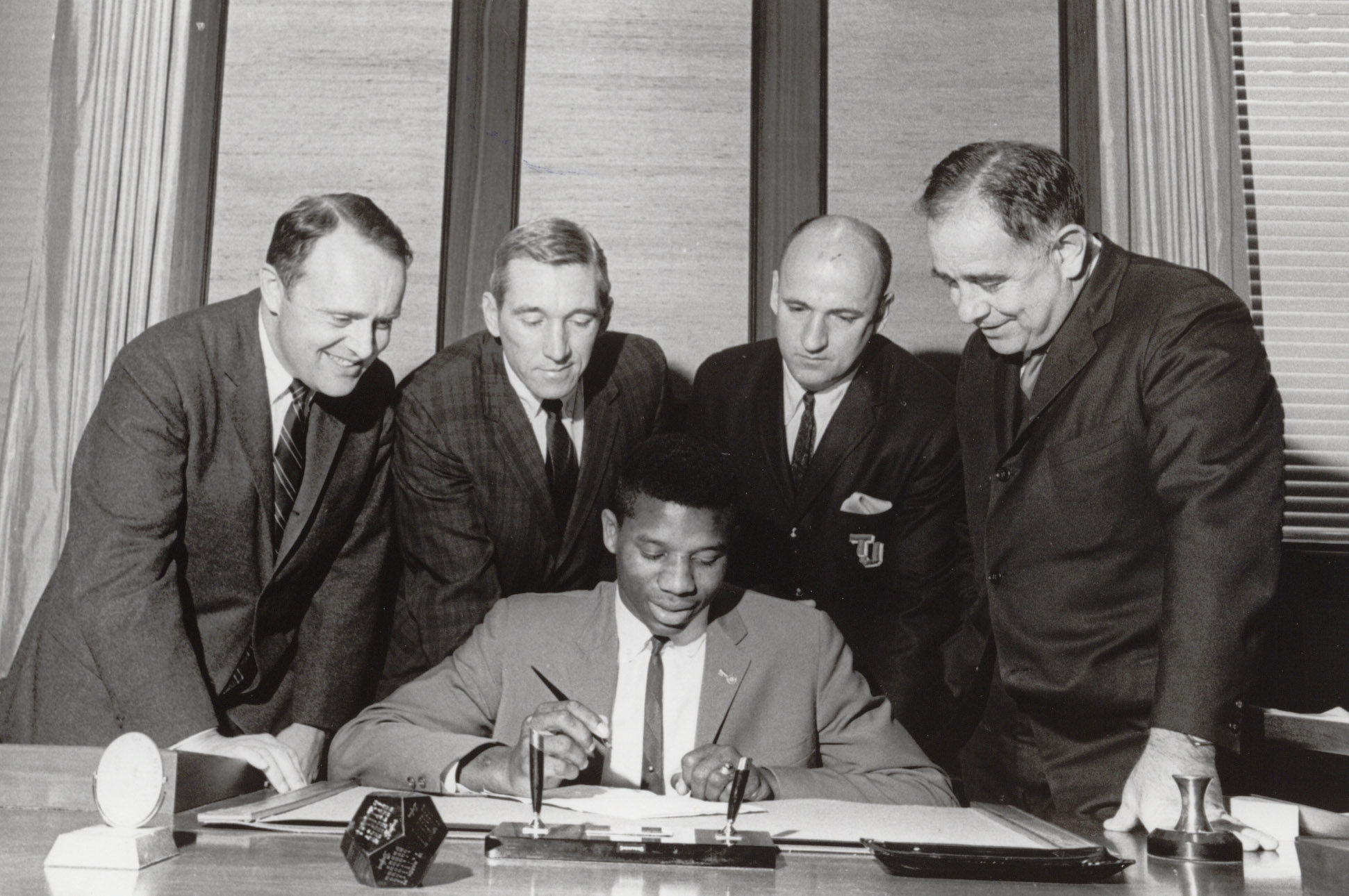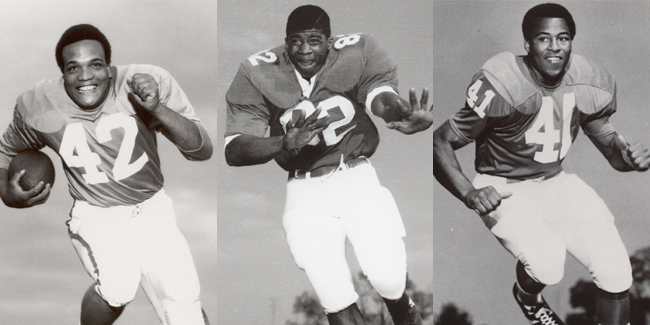
LEXINGTON, Ky. — Perhaps the clearest tribute to the work that Nate Northington, Greg Page, Houston Hogg and Wilbur Hackett did half a century ago is that it is unimaginable that 50 years ago, there were no African-Americans playing SEC sports.
But while unimaginable, it is true, and accordingly it is probably overdue when Thursday night, the University of Kentucky will unveil a new statue outside Commonwealth Stadium in tribute to the four pioneers who forever changed the game by integrating football in the Southeastern Conference. The university also will honor the players at Saturday’s game against South Carolina.
In terms of integration, Northington came first. A receiver and defensive back from Louisville, Northington (below) was essentially chosen by Kentucky’s governor, Ned Breathitt, UK’s president, John Oswald, and football coach Charlie Bradshaw as the player to break the SEC color barrier.

UK basketball had previously recruited African-American stars Wes Unseld and Butch Beard, with Beard even committing to UK. But if most people agreed that it was time to integrate the Southeastern Conference, it was quite another thing for a mother and father to want their son to be that Jackie Robinson figure.
The plan, as was related in December 1965, when Northington signed, was for Northington to have another African-American teammate. Lineman Greg Page of Middlesboro, Ky., was that player. Page signed, and went through freshman football with Northington in 1966.
But in the fall of 1967, as Northington and Page prepared for their first varsity season, Page suffered a severe spinal injury during a practice drill conducted in shorts and a helmet. Northington had to carry on alone. He continued to practice, coming back to a dorm room that was empty except for Page’s personal effects, which sat untouched while Greg struggled in a nearby hospital. Page was hospitalized for 38 days, during which time Northington was the only UK player who could visit him. On Sept. 29, 1967, Greg Page passed away.

The next day, Northington broke the SEC color barrier, logging a few minutes of playing time at cornerback in a home game against Ole Miss. Northington separated his shoulder, and between his grief at the loss of Page and the difficulties of being the first African-American player in the SEC, he neglected his classes enough that the UK coaches cut his meal plan. He played a few more minutes in a few more games, but Northington decided before the 1967 season ended that he had to move on, and he transferred to Western Kentucky University.
But before he left UK, in one last pivotal act, he gathered three freshman African-American players and told them that he couldn’t make it any longer, but that they had to stay. Two of the three, Houston Hogg and Wilbur Hackett, did stay for all four years.
Hogg was a reserve running back who grew up in Hazard, Ky., and graduated from high school in Owensboro. But Hackett was a 5-10 dynamo of a linebacker, and he became the undersized heart of new coach John Ray’s defenses. Hackett, who hailed from Louisville, not only played for his four years, but he became a team captain and won several MVP awards for the 1970 Wildcats.
The path for the four players was not easy. Of course, Page passed away before playing in a varsity game, after suffering his unlikely injury. Northington tried to tune out the racial slurs that he heard at road games, but he acknowledges that he endured ferocious taunts from opposing players and fans. For his part, Hackett later recalled poor treatment at the hands of Mississippi police and being kicked out of a restaurant in Louisiana. Hogg recently remembered receiving death threats on the road as well.
Now, approaching the 50th anniversary of their historical contributions to the Southeastern Conference, all four pioneers — Northington, Page, Hogg, and Hackett —are honored with the new statute and with recognition at this weekend’s game.
Hogg recently told an interviewer, “The fact that they’re doing it (building and unveiling the statue), it’s like what we went through is turning out to be worth what we went through.”

Kentucky also copied the planned statute’s design in their 2016 schedule poster, with current players standing in the place of the pioneers. The poster features a theme of “Make a Stand,” an obvious reference to the trailblazers who are to be honored.
The numbers of current players correspond with the jerseys worn by the four honorees: Page was No. 82, Northington 23, Hackett 41 and Hogg 42.
“No four players in our program’s history have better demonstrated the values of courage, determination and selflessness than Nate, Greg, Wilbur and Houston,” Kentucky athletic director Mitch Barnhart recently said. “The pride we take in calling them Kentucky Wildcats is matched only by our gratitude for what they have done for this university and for college football in the South.”
Indeed, within five years of Northington’s debut, all of the SEC member schools had integrated their football teams.
At the time, the SEC’s hold as a preeminent football conference had been perilous — as an integrated Southern California team famously outshone Bear Bryant’s all-white Alabama squad in 1970.
But due in large part to the courage and tenacity of Kentucky’s four pioneers, the SEC quickly made up for lost time, and college football brought about great strides in racial healing in the American south.
As Kentucky takes a moment to honor these heroes, it would only be appropriate if the rest of the league did likewise. Before there was Teez Tabor or Jalen Hurts or Leonard Fournette or Nick Chubb, there were four young men at Kentucky with the courage to make the dream of integrated SEC football a reality.
Photos provided by UK Athletics
Joe Cox is a columnist for Saturday Down South. He has also written or assisted in writing five books, and his most recent, Almost Perfect (a study of baseball pitchers’ near-miss attempts at perfect games), is available on Amazon or at many local bookstores.







